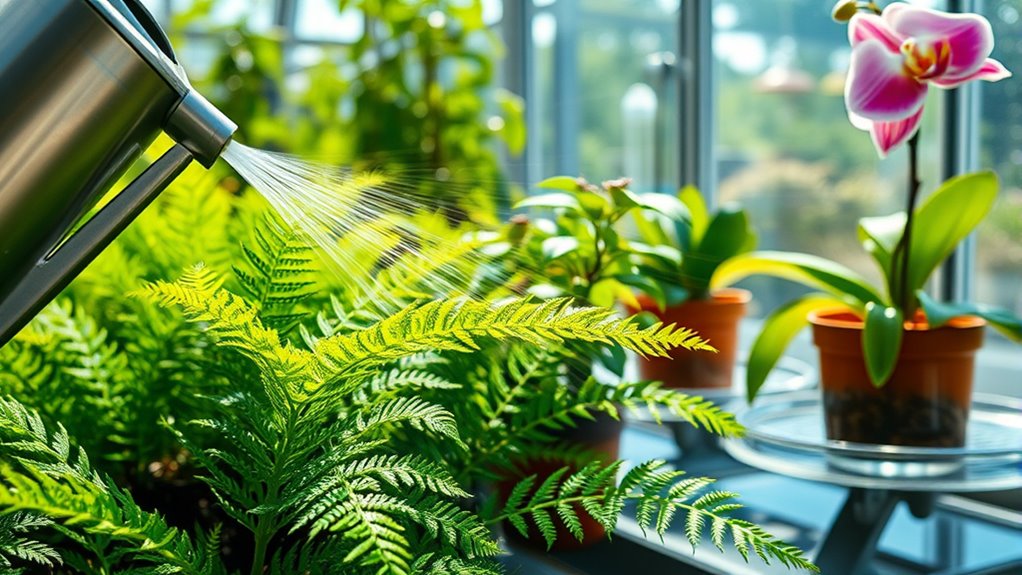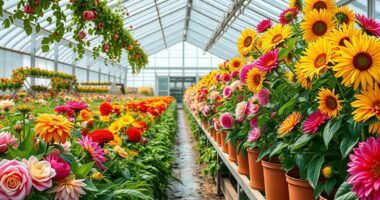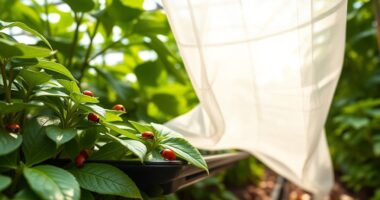To develop effective watering strategies for your greenhouse plants, tailor your approach to each type. For succulents and cacti, water deep but infrequently to avoid root rot. Tropical plants need consistent moisture but well-draining soil. Leafy greens and herbs prefer moist but not soggy soil, while flowering plants benefit from regular deep watering. Adjust your schedule based on growth stages, humidity, and season, ensuring healthy growth. Explore more insights to optimize your plant care.
Key Takeaways
- Adjust watering frequency based on each plant’s growth stage and water needs, increasing during flowering and reducing in dormancy.
- Use soil moisture sensors and regular checks to prevent overwatering and root rot across different plant types.
- Employ targeted watering techniques like drip irrigation for precise delivery to roots, minimizing excess moisture.
- Maintain proper soil drainage and avoid water pooling, especially for succulents, cacti, and tropical plants.
- Adapt watering schedules seasonally, increasing during warm months and reducing in winter, based on environmental conditions.
Understanding the Watering Needs of Succulents and Cacti

While succulents and cacti are known for their drought tolerance, understanding their specific watering needs is essential for healthy growth. Succulent drought tolerance means they can survive long periods without water, but overwatering can cause root rot. Proper watering is key to maintaining their structural integrity and preventing issues like rot or dehydration. Check the soil moisture regularly, and remember that these plants prefer deep, infrequent watering over shallow, frequent sessions. Seasonal adjustments are important, as cactus watering frequency varies depending on the season, with less frequent watering during winter dormancy. Typically, you should water only when the soil is completely dry, usually every couple of weeks in warmer months. Utilizing appropriate watering techniques ensures your plants stay healthy and thrive. Incorporating watering schedules based on seasonal changes can further optimize plant health. Additionally, understanding soil moisture levels helps prevent both underwatering and overwatering, promoting optimal growth.
Proper Watering Techniques for Tropical Plants
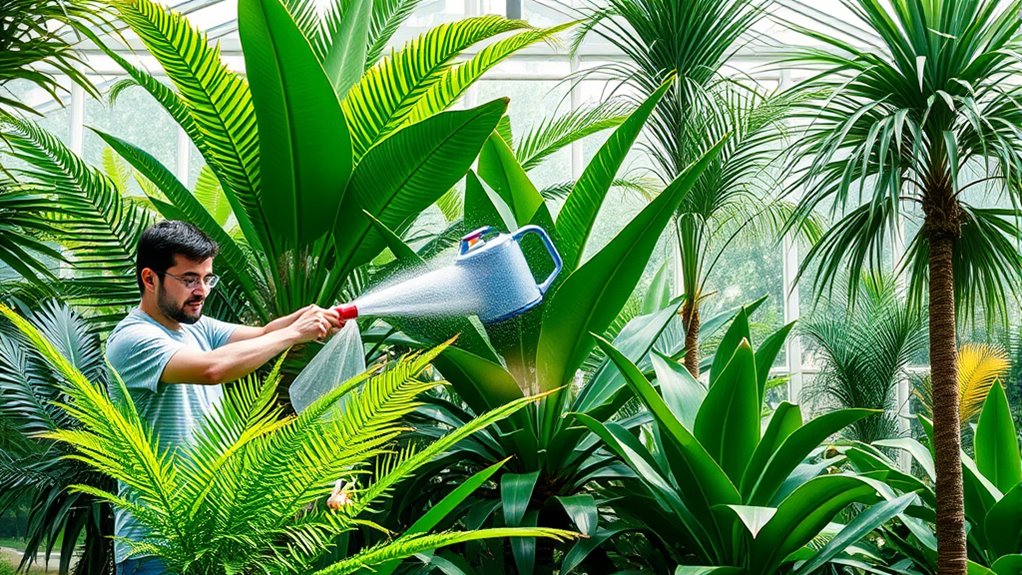
To keep your tropical plants healthy, maintain consistent moisture levels without overwatering. Too much water can lead to root rot and other problems, so it’s important to find the right balance. Let the top inch of soil dry out slightly between watering to avoid these risks. Incorporating energy-efficient watering systems can help optimize water usage and promote healthier plant growth. Additionally, understanding the retail hours of local garden centers can assist in scheduling your watering and plant care routines more effectively. Monitoring soil moisture levels with a moisture meter can further enhance your watering routine by providing precise data for each plant’s needs. Staying informed about AI-driven diagnostics in horticulture can also help identify issues early and ensure your plants thrive.
Consistent Moisture Levels
Maintaining consistent moisture levels is essential for the health of tropical plants in a greenhouse. Different soil types retain water differently, so adjusting your watering frequency is key. Loamy soil holds moisture longer, needing less frequent watering, while sandy soil drains quickly, requiring more regular watering. Observe your plants for signs of drought or overwatering, such as wilting or yellowing leaves. Use a moisture meter or finger test to check soil moisture regularly. To help, here’s a quick guide:
| Soil Type | Watering Frequency | Tips |
|---|---|---|
| Loamy | Every 4-5 days | Maintain even soil moisture |
| Sandy | Every 2-3 days | Ensure thorough watering |
| Clay | Every 5-6 days | Avoid waterlogging |
| Organic | Every 3-4 days | Keep soil consistently moist |
Additionally, understanding how plant health is affected by watering practices can help optimize your care routines. Proper watering techniques can also influence disease prevention and overall plant vigor, especially considering the importance of soil moisture retention for tropical plant growth. Recognizing how watering frequency impacts plant vitality can further refine your greenhouse management strategies. Maintaining appropriate watering schedules can also promote root development and prevent common issues such as root rot or dehydration.
Avoid Overwatering Risks
Overwatering is a common mistake that can harm your tropical plants, leading to root rot and other health issues. To prevent this, guarantee your greenhouse has proper drainage systems that allow excess water to escape efficiently. Proper drainage systems are essential for maintaining the right soil moisture levels and preventing waterlogged soil, which is critical for healthy root development. Additionally, soil moisture levels should be monitored regularly to ensure proper watering habits. Adjust your watering frequency based on the plant’s needs, avoiding daily watering unless the environment is particularly dry. Check the soil’s moisture level before watering; wait until the top inch feels dry. Overwatering often occurs when you water on a fixed schedule regardless of soil conditions. Incorporating security measures like monitoring systems can help prevent unintended overwatering caused by system failures or accidental overuse. Implementing watering schedules based on real-time soil data can further optimize your watering routine. Moreover, understanding the operating hours of nearby retail stores can help you plan your watering schedule to avoid unnecessary trips during busy times.
Managing Moisture Levels for Leafy Greens and Herbs
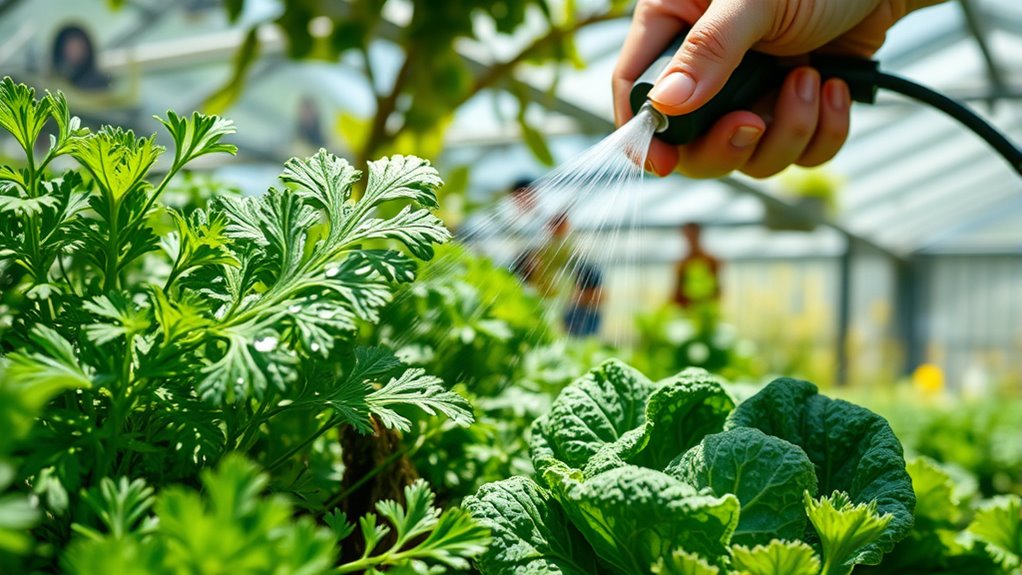
Because leafy greens and herbs are especially sensitive to excess moisture, managing their moisture levels carefully is essential for healthy growth. You should focus on optimizing soil drainage to prevent water from pooling around roots, which can lead to root rot. Use well-draining soil mixes that balance water retention with proper airflow. Additionally, adjusting watering angles can significantly influence how water interacts with the soil, helping to maintain appropriate moisture levels. Consistently monitor soil moisture to avoid overwatering or drought stress. Water only when the top inch of soil feels dry, ensuring the soil retains enough moisture without becoming waterlogged. Proper watering techniques, combined with good ventilation, help maintain the delicate balance needed for these plants.
Watering Strategies for Flowering Plants in the Greenhouse
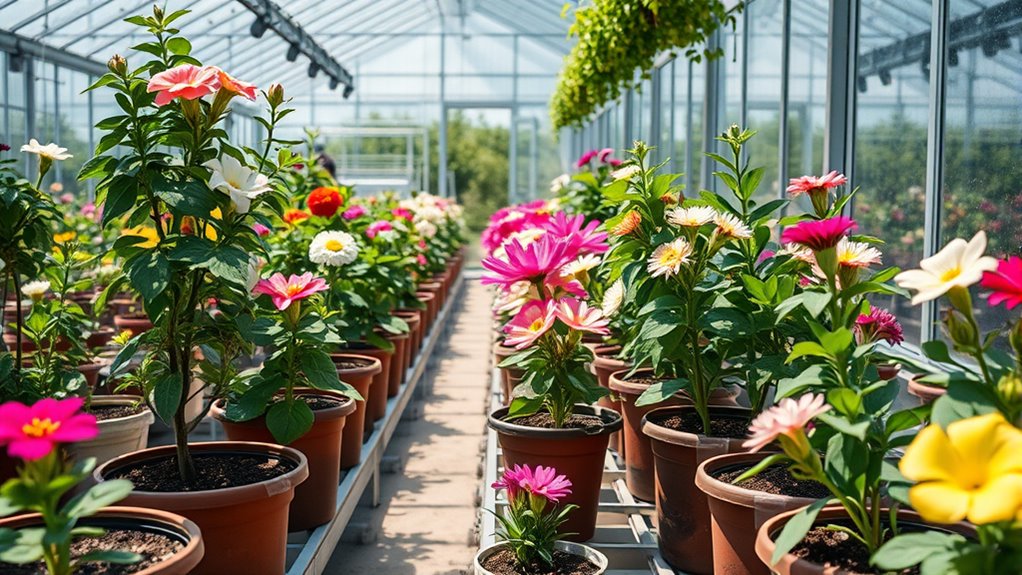
While managing moisture levels for leafy greens and herbs focuses on preventing excess water, flowering plants in the greenhouse require a slightly different approach to promote vibrant blooms and healthy growth.
Proper watering ensures that flowering plant fertilization is effective and that plants don’t suffer from root rot or dehydration. You should water deeply when the top inch of soil feels dry, avoiding frequent shallow watering.
Regular flowering plant pruning encourages better air circulation and stimulates new growth, enhancing blooms. Additionally, consistent watering helps maintain nutrient uptake for suitable flowering.
Keep in mind that overwatering can weaken stems and reduce flowering, so monitor soil moisture carefully. Adjust your watering schedule based on the plant’s specific needs and growth stage to ensure continuous, vibrant flowering.
Adjusting Watering Schedules During Different Growth Stages
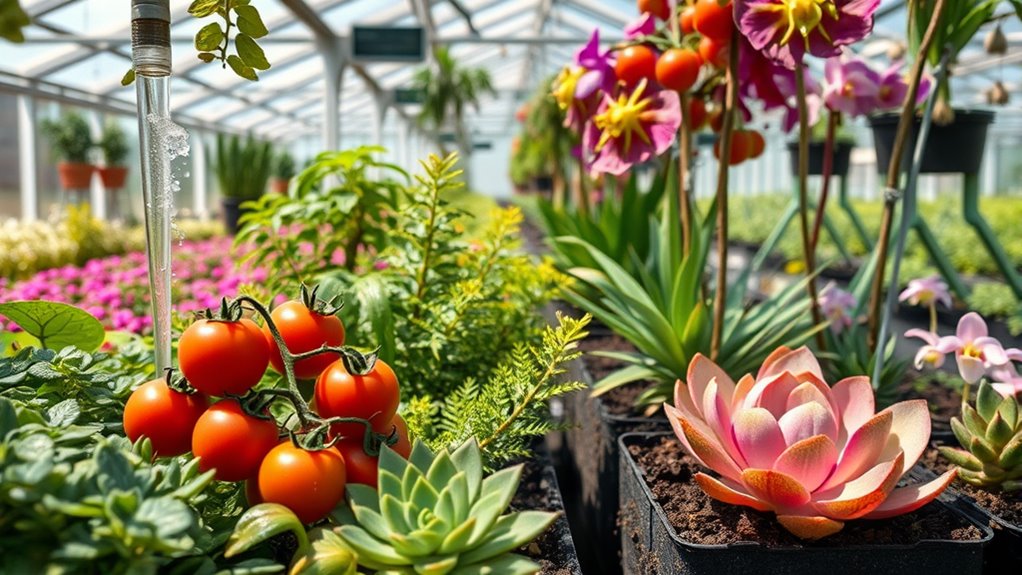
Adjusting your watering schedule as plants progress through different growth stages is essential for maintaining healthy greenhouse crops. During early stages, roots are delicate and need consistent moisture to develop the root zone effectively.
As plants grow, their water retention needs change; they might require deeper, less frequent watering to encourage strong root systems. In vegetative stages, guarantee the water reaches the root zone without oversaturating, which could lead to root rot.
During flowering or fruiting, slightly increase watering frequency to support the increased demand. Monitoring soil moisture levels helps prevent over- or under-watering, promoting ideal water retention in the root zone.
Adapting your schedule ensures plants get the right amount of water at each stage, fostering healthy growth and high yields.
The Role of Humidity and Ventilation in Plant Watering

Humidity levels directly influence how much water your plants need, with higher humidity reducing their evaporation rate.
Proper ventilation helps regulate humidity and promotes consistent watering, preventing issues like overwatering or drought stress.
Understanding how these factors interact allows you to optimize watering for healthier greenhouse plants.
Humidity’s Impact on Water Needs
Humidity levels substantially influence how much water your greenhouse plants need. High humidity reduces vapor pressure deficits, meaning plants lose less water and require less frequent watering. Conversely, low humidity increases vapor pressure, prompting plants to transpire more and need more frequent watering.
Proper humidity control helps maintain ideal moisture levels, preventing over- or underwatering. Keep in mind:
- Maintaining consistent humidity supports healthy root development
- Excess humidity can lead to fungal issues, affecting water uptake
- Adjust watering schedules based on humidity fluctuations
- Ventilation helps regulate humidity, balancing vapor pressure for efficient watering
Understanding humidity’s role allows you to fine-tune watering strategies, ensuring your plants stay healthy and thrive in the right moisture environment.
Ventilation and Evaporation Rates
Ventilation plays a crucial role in controlling evaporation rates within your greenhouse, directly impacting how much water your plants need. Proper air circulation helps regulate humidity levels, preventing excessive moisture loss or buildup.
When airflow is strong, it reduces stagnant air pockets, promoting even humidity control and lowering evaporation rates. Conversely, poor ventilation can cause high humidity, leading to slower evaporation and potential disease issues.
By optimizing ventilation, you guarantee that moisture levels stay balanced, so plants don’t dry out too quickly or stay overly damp. This balance allows you to tailor your watering schedule more precisely, avoiding overwatering or underwatering.
Ultimately, good ventilation enhances plant health by maintaining consistent humidity and evaporation rates, supporting efficient water use.
Techniques for Preventing Overwatering and Root Rot

Overwatering is a common mistake that can lead to root decay and damage your greenhouse plants. To prevent this, use techniques like drip irrigation, which delivers water directly to the roots, reducing excess moisture.
Establish consistent watering schedules based on each plant’s needs, avoiding arbitrary or frequent watering. Make sure your pots have proper drainage to prevent water from pooling.
Additionally, monitor soil moisture regularly to catch overwatering early.
- Use drip irrigation for precise watering
- Follow tailored watering schedules for each plant
- Ensure pots have adequate drainage holes
- Check soil moisture to adjust watering practices
Using Soil Moisture Indicators to Optimize Watering

Monitoring soil moisture is a practical way to guarantee your greenhouse plants receive the right amount of water. Soil moisture levels tell you exactly when and how much to water, preventing both under- and overwatering. Indicator technology, such as moisture meters or sensors, makes this process straightforward.
Monitoring soil moisture ensures healthy greenhouse plants by providing precise watering guidance with easy-to-use sensors.
These tools provide real-time data, allowing you to assess soil moisture quickly and accurately. By using soil moisture indicators, you avoid guesswork and ensure your plants stay healthy.
Proper moisture levels promote ideal growth and reduce problems like root rot caused by excess water. Integrating soil moisture monitoring into your routine helps you develop a precise watering schedule, conserving water and improving plant robustness.
This approach keeps your greenhouse thriving and minimizes water waste.
Seasonal Watering Adjustments for Greenhouse Plants
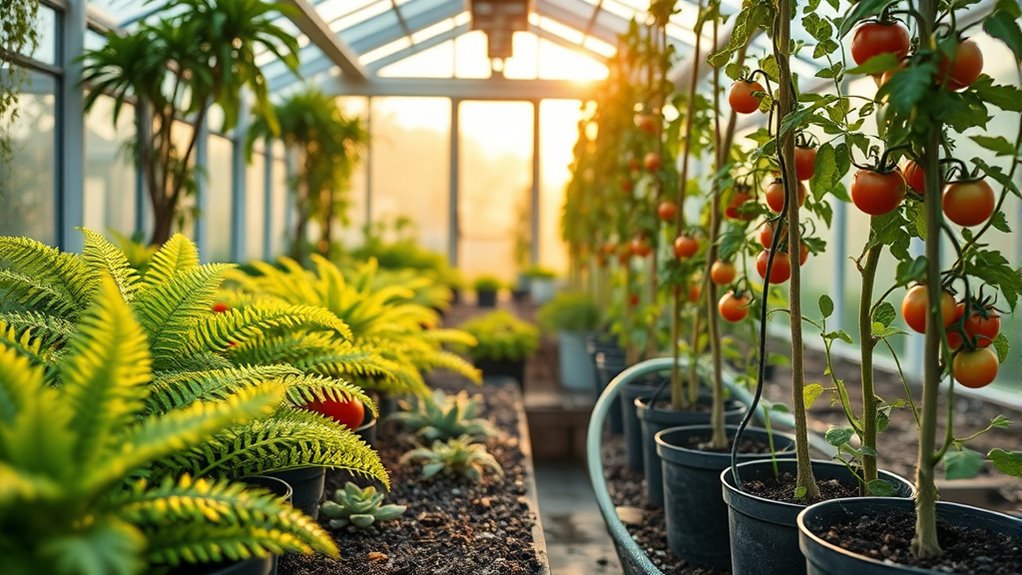
As seasons change, so do the watering needs of your greenhouse plants. During warmer months, you might need to increase watering frequency to prevent seasonal drought stress.
In winter, reduce watering, but don’t neglect winter watering to avoid root rot from excess moisture. Adjustments are vital because plants respond differently depending on the season’s humidity and temperature.
- Recognize signs of drought stress in summer and early fall
- Decrease watering frequency during colder months
- Use winter watering strategies to prevent dehydration
- Monitor soil moisture closely to avoid overwatering or underwatering
These seasonal adjustments help maintain healthy growth year-round, ensuring your plants stay vibrant and resilient regardless of the weather outside.
Frequently Asked Questions
How Do I Identify Underwatered Versus Overwatered Plants?
To tell if your plants are underwatered or overwatered, check the root zone and leaves. If the roots are dry and the leaves are wilting, your plant likely needs more water.
Conversely, if the roots are soggy and the leaves are yellow or mushy, it’s overwatered. Adjust your watering schedule accordingly, ensuring you maintain a balance that keeps the root zone moist but not waterlogged.
What Are the Signs of Water Stress in Greenhouse Plants?
Imagine you’re a detective in a Victorian novel, searching for clues of water stress. You notice leaf wilting, which signals your plant’s struggling.
Overwatering may cause root rot, turning roots mushy and foul-smelling, while underwatered plants show dry, crispy leaves. Keep a close eye on these signs, and you’ll catch water stress early, ensuring your greenhouse plants stay healthy and vibrant.
Can Automated Watering Systems Adapt to Plant Needs?
Automated watering systems can adapt to plant needs if you regularly calibrate sensors to guarantee accurate readings.
By adjusting sensor calibration, you control watering frequency based on real-time soil moisture data. This means your system can provide just the right amount of water, reducing waste and stress on your plants.
Proper calibration and monitoring help the system respond dynamically to changing moisture levels, keeping your greenhouse healthy and thriving.
How Does Watering Impact Disease Prevention in Greenhouses?
Watering plays a vital role in disease prevention in your greenhouse. Using drip irrigation helps deliver water directly to the roots, reducing leaf wetness that fosters fungi and bacteria.
Additionally, controlling humidity levels prevents excess moisture that encourages disease spread.
Proper watering practices, combined with these methods, keep plants healthier, lowering the risk of infections and promoting a more resilient greenhouse environment.
Are There Eco-Friendly Watering Options Suitable for Greenhouses?
You’re really on the ball considering eco-friendly watering options. Think of sustainable watering as hitting two birds with one stone—saving resources and protecting the environment.
Eco-friendly irrigation methods like drip systems, rainwater harvesting, and soaker hoses minimize water waste and energy use. These choices not only support a greener greenhouse but also boost plant health, making your setup more sustainable and efficient in the long run.
Conclusion
By understanding each plant’s unique watering needs and adjusting your techniques accordingly, you’ll keep your greenhouse thriving. Remember, overwatering can be just as harmful as underwatering, so stay attentive to moisture levels. Are you ready to fine-tune your watering strategies and watch your plants flourish? With a little practice and observation, you’ll become confident in providing the perfect hydration for all your greenhouse plants. Happy gardening!
